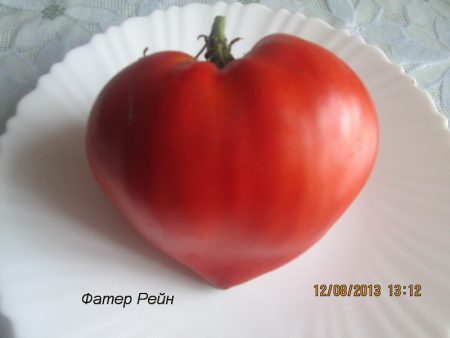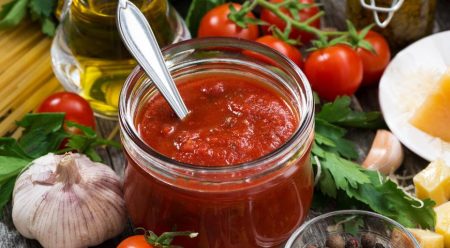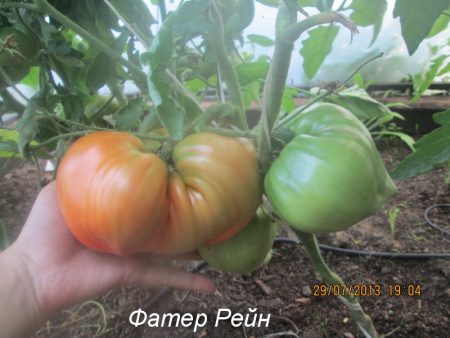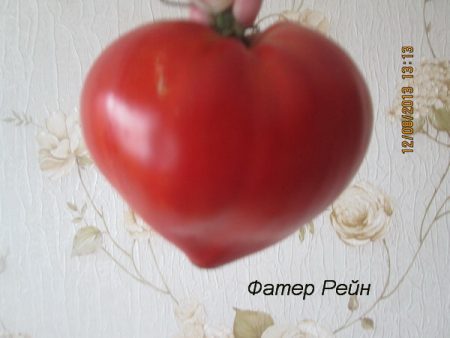 Bright saturated taste, high productivity, unusual heart-shaped form - all these qualities are combined in tomatoes Fater Rhine. The German tomato variety is famous for its high yields and large fruits, which sometimes reach 1 kilogram.
Bright saturated taste, high productivity, unusual heart-shaped form - all these qualities are combined in tomatoes Fater Rhine. The German tomato variety is famous for its high yields and large fruits, which sometimes reach 1 kilogram.
Content
Characterization and description of the variety
The mid-season tomato variety Vater Rhine is recommended to be grown in greenhouse conditions. Bushes reach a height of 1.5 meters, plants with medium leafiness.
One fruit weighs approximately 450-600 grams, the shape of a tomato in the form of a heart with a sharp small nose on the top, when ripe, the tomatoes acquire a bright red color. The pulp is juicy, fleshy, almost seedless, has a sweet and sour taste.
The fruit ripening period is 95-105 days. When a plant is formed in 2-3 stems, one bush brings about 4-6 kg of tomatoes, and 15-20 kg of tomatoes are harvested from one square.
Advantages and disadvantages of the variety
Tomatoes Fater Rhine perfectly combines taste, originality of form and productivity, they have many advantages:
- excellent taste;
- attractive appearance;
- high productivity;
- tomatoes are universal in use;
- fleshy seedless flesh.
The disadvantages of the variety:
- plants do not tolerate cold;
- bushes require constant garter;
- Tomatoes can only be grown in greenhouse conditions.
Grade purpose
Tomatoes are used in salads, eat fresh, they are suitable for the preparation of ketchups, sauces, mashed potatoes. Smaller fruits can be preserved for the winter.
Growing Features
Universal primer for planting is available at the store. It is easy to prepare such a mixture at home, take nutrient soil, add sand and peat additives (2: 1: 1). Before planting, the seed material must be soaked in a solution of potassium permanganate in order to avoid diseases.
Seeds at the end of February are planted in containers, sprinkled with a layer of earth and watered. You can cover the container for several days with a film, for quick shoots, it is better to move the containers closer to the light in a warm place.
After 8-10 days after sowing, sprouts appear, the film material is removed, and the seedlings are moved to a cool room (temperature 14-16 degrees), this is done to harden the seedlings. After a week, the temperature begins to gradually rise until it reaches 22-24 degrees. Watering the earth during seedling growth is necessary as necessary, excess moisture can cause root decay.
A transplant with an individual container is done when the seedlings get stronger and release a couple of leaves. Seedlings need good lighting, if it is not enough, you can additionally turn on fluorescent lamps. Daylight hours should be for seedlings at least 16 hours.
The greenhouse is best located in the southern or southwestern part of the garden. After 55-65 days, the seedlings are transferred to the site. Land for planting needs to be prepared in advance, organic and mineral fertilizers should be applied, then the site should be dug up. Seedlings are planted in the wells, the soil is compacted and watered. The planting scheme of bushes is 30 cm by 40 cm. Near the bushes, a support for the garter should be installed. After a couple of weeks, they make the first garter on the plants. No more than 3 plants are planted per square meter.
Tomato Care
Basic requirements for plant care:
- hilling of the soil is carried out 2-3 times per season;
- the bushes are quite high, so every 2-3 weeks, as they grow, they make a garter of the bushes;
- timely watering: pour a liter of water under one bush, it is better to water in the evening, when the sun has already set;
- weeds should be removed regularly;
- tomatoes are fertilized three times during the summer, organics are added 15 days after planting, you can mix manure with superphosphate, mineral additives are added every next two weeks.

Diseases and pests
If you allow high humidity in the greenhouse, a number of diseases can occur:
- Septoria;
- late blight;
- vertex rot;
- macrosporiosis.
Copper sulfate (4-5%) is used against fungal diseases, Barrier or Hom preparations are used, fertilizing with potash fertilizers can also give results in the fight against diseases.
Harmful insects love to settle on delicious tomatoes, among them: aphids, bears, whiteflies. Insecticides will help to overcome pests.
Vater Rhine cultivation regions
Semi-determinant German type of tomato is grown in central Russia in closed ground. The variety is unstable to frost, therefore, in the western, northwestern and southwestern regions of the country, tomatoes are grown in greenhouses.
Reviews
Svetlana, Chelyabinsk
The taste of tomatoes on the Vater Rhine is simply fabulous. There are few seeds in the fruits. 3-4 tomatoes ripen in the brush. The crop was average. Due to the taste, I will plant tomatoes again.
Natalya, Moscow
Bushes can not be called powerful, there are not many leaves and stepsons. She led bushes in 3 trunks. Fruits of the same shape with an elongated nose. The variety was one of the first to ripen. Definitely this variety of tomatoes in plans for planting next year.
Elena, Kostroma
The fruits are beautiful, the nose is not very elongated. Seedlings were weak, there are very few seeds in tomatoes, but the taste did not disappoint, the flesh is fleshy and tasty.




 Low-growing tomatoes, without pinching: 5 of the most delicious varieties
Low-growing tomatoes, without pinching: 5 of the most delicious varieties Why tomato seedlings grow poorly
Why tomato seedlings grow poorly We grow a tomato in a shell
We grow a tomato in a shell Growing tomatoes without watering according to the method of Kazarin
Growing tomatoes without watering according to the method of Kazarin